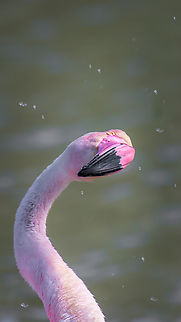
Appearance
This is the largest species of flamingo, averaging 110–150 cm tall and weighing 2–4 kg. The largest male flamingos have been recorded at up to 187 cm tall and 4.5 kg. It is closely related to the American flamingo and Chilean flamingo, with which it has sometimes been considered conspecific, but that treatment is now widely seen as incorrect and based on insufficient evidence.Like all flamingos, this species lays a single chalky-white egg on a mud mound. Most of the plumage is pinkish-white, but the wing coverts are red and the primary and secondary flight feathers are black. The bill is pink with a restricted black tip, and the legs are entirely pink. The call is a goose-like honking. Sub-adult flamingos are whitish-grey and only attain the pink coloration several years into their adult life. The coloration comes from the carotenoid pigments in the organisms that live in their feeding grounds.
The bird resides in mudflats and shallow coastal lagoons with salt water. Using its feet, the bird stirs up the mud, then sucks water through its bill and filters out small shrimp, seeds, blue-green algae, microscopic organisms and mollusks. The greater flamingo feeds with its head down and its upper jaw is movable and not rigidly fixed to its skull.
References:
Some text fragments are auto parsed from Wikipedia.
